Related Research Articles
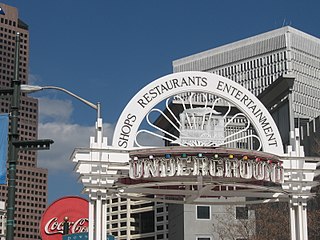
Underground Atlanta is a shopping and entertainment district in the Five Points neighborhood of downtown Atlanta, Georgia, United States, near the Five Points MARTA station. It is currently undergoing renovations. First opened in 1969, it takes advantage of the viaducts built over the city's many railroad tracks to accommodate later automobile traffic.
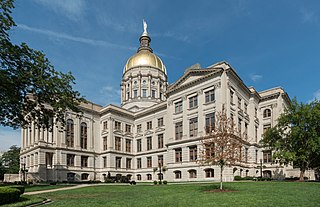
The Georgia State Capitol is an architecturally and historically significant building in Atlanta, Georgia, United States. The building has been named a National Historic Landmark which is listed on the National Register of Historic Places. As the primary office building of Georgia's government, the capitol houses the offices of the governor, lieutenant governor, and secretary of state on the second floor, chambers in which the General Assembly, consisting of the Georgia State Senate and Georgia House of Representatives, meets annually from January to April. The fourth floor houses visitors' galleries overlooking the legislative chambers and a museum located near the rotunda in which a statue of Miss Freedom caps the dome.
Logan Edwin Bleckley was an American lawyer and jurist.

Rufus Brown Bullock was a Republican Party politician and businessman in Georgia. During the Reconstruction Era he served as the state's governor and called for equal economic opportunity and political rights for blacks and whites in Georgia. He also promoted public education for both, and encouraged railroads, banks, and industrial development. During his governorship he requested federal military help to ensure the rights of freedmen; this made him "the most hated man in the state", and he had to flee the state without completing his term. After returning to Georgia and being found "not guilty" of corruption charges, for three decades afterwards he was an esteemed private citizen.
The Viaducts of Atlanta were mainly created in the 1920s to bridge numerous level crossings of roads and railroads.
The Georgia Multi-Modal Passenger Terminal (MMPT) was a planned passenger terminal, designed by FXFOWLE Architects and Cooper Carry, to be built in a location to be determined near the Five Points MARTA rail station in The Gulch area of Downtown Atlanta. It would be the hub of existing and proposed transportation networks, including the existing MARTA rail and bus systems, the Xpress GA and other regional express buses, and the planned commuter rail system.
The following is a timeline of the history of the city of Atlanta, Georgia, United States.

A general election was held in the U.S. state of Georgia on November 6, 2018. All of Georgia's executive officers were up for election as well as all of Georgia's fourteen seats in the United States House of Representatives. Neither U.S. Senate seat was up for election in 2018. The Republican Party won every statewide office in 2018.
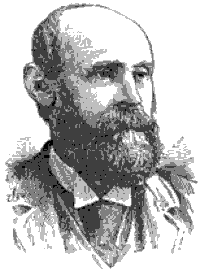
Alexander Campbell Bruce (1835–1927), also known as A. C. Bruce, was an American architect based in Atlanta, Georgia.

Haralson Bleckley was an American architect who designed many buildings in his hometown of Atlanta, Georgia. Several of his works are listed on the National Register of Historic Places (NRHP). His office was in the Flatiron Building. He also proposed the Bleckley Plaza Plan, a largescale architectural project that would have seen the creation of a large plaza in downtown Atlanta.

The Lutheran Church of the Redeemer is a Lutheran church in midtown Atlanta, Georgia. The congregation was founded in the city in 1903, with the current building constructed in 1952.

Liberty Plaza is a public plaza in downtown Atlanta, Georgia, adjacent to the Georgia State Capitol. Completed in 2015, the 2.2-acre plaza is capable of holding over 3,000 people and has hosted numerous political demonstrations in Atlanta.
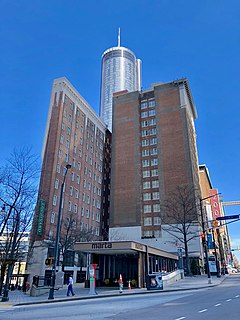
This article is about hotels in Atlanta, including a brief history of hotels in the city and a list of some notable hotels.

All Saints' Episcopal Church is an Episcopal church in Atlanta, Georgia. The church was founded in 1903, with the current building constructed in 1906.

The equestrian statue of John Brown Gordon is a monument on the grounds of the Georgia State Capitol in Atlanta, Georgia, United States. The monument, an equestrian statue, honors John Brown Gordon, a general in the Confederate States Army during the American Civil War who later become a politician in post-Reconstruction era Georgia. Designed by Solon Borglum, the statue was dedicated in 1907 to large fanfare. The statue has recently become a figure of controversy over Gordon's racist views and associations with the Confederacy, with some calling for its removal.
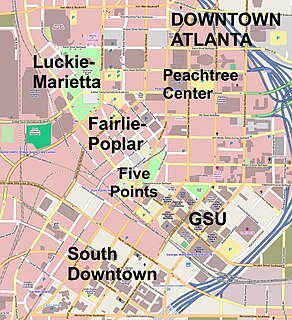
The Martin Luther King Jr. statue is a public monument of civil rights activist Martin Luther King Jr. in Atlanta, Georgia. The statue, designed by Martin Dawe, was unveiled in 2017 and stands on the grounds of the Georgia State Capitol, overlooking Liberty Plaza.

The Thomas E. Watson statue is a public monument located near the Georgia State Capitol in Atlanta, Georgia. Dedicated in 1932, the statue honors Georgian politician Thomas E. Watson, who served terms in the United States Congress as both a Representative and Senator in the late 1800s and early 1900s. Originally located on the steps of the capitol building, the statue was removed from this location in 2013 and relocated to a nearby plaza.

Druid Hills Presbyterian Church is a historic Presbyterian church in Atlanta, Georgia, United States. The church was founded in 1883 in downtown Atlanta and moved to near the Druid Hills neighborhood in 1910. The current church building, designed by Francis Palmer Smith, was completed in 1940 and is located in the Virginia–Highland neighborhood.

Fire Station No. 6 is a historic fire station in Atlanta, Georgia, United States. Built in 1894 with designs by Bruce & Morgan, the building is the oldest freestanding fire station in the city. Located in the Sweet Auburn neighborhood, the building is a contributing property in the Martin Luther King Jr. National Historical Park.
Oglethorpe Park was a municipal park in Atlanta, Georgia, United States. The park, consisting of about 50 acres (20 ha), was created in 1869 and hosted numerous fairs, most notably the International Cotton Exposition in 1881. Following this exposition, the park was sold by the city and was converted into the Exposition Cotton Mills, utilizing facilities that had been built for the event. The closure of the park indirectly contributed to the creation of two later parks in Atlanta: Grant Park and Piedmont Park.
References
- 1 2 3 Morrison 2019, p. 45.
- 1 2 3 4 5 Garrett 1969, p. 685.
- 1 2 3 Hoffman 1968, p. 58.
- ↑ Hoffman 1968, pp. 57–58.
- ↑ Lands 2009, p. 67.
- ↑ Morgan 1937, p. 12.
- ↑ Lands 2009, p. 65.
- ↑ Lands 2009, pp. 66–67.
- ↑ Morgan 1943, pp. 93–94.
- ↑ Morgan 1943, p. 94.
- 1 2 Hoffman 1968, p. 59.
- ↑ Lands 2009, p. 68.
- ↑ Salzer 2014.
- ↑ Bluestein 2016.